COVID-19 Alaska Weekly Case Update: July 19-25, 2020
Alaska Department of Health sent this bulletin at 07/29/2020 12:54 PM AKDT
This data summary covers COVID-19 in Alaska from Sunday, July 19th through Saturday, July 25th, 2020.
Background
The Alaska COVID-19 Weekly Case Update will be finalized every weekend with data from the previous week and the report will be published by the following Wednesday. Data are continually updated on the Alaska Coronavirus Response Data Hub, which reflects the most current case counts. This summary presents data from the previous week and is a snapshot of the information available on known cases at the time.
Highlights
- This has been Alaska’s worst week of the pandemic in terms of rapid increases in resident and nonresident new cases.
- Total cases in Alaska residents rose 34% this week.
- The majority of new cases are among Alaskans aged 20-29, with cases among Alaskans in their 20s and 30s rising sharply.
- Most nonresident cases have been identified before the person had significant community interaction, so most new cases in Alaskans are acquired from other Alaskans who have not traveled.
- Hospital capacity is currently adequate, but hospitalizations and deaths are increasing
- With current rates of physical distancing, face covering use and other measures to prevent transmission, cases are expected to continue to rise rapidly.
- Alaskans should avoid large and indoor gatherings, wear face coverings in public, keep six feet of distance from non household members and practice good hand hygiene to slow transmission of COVID-19.
Major Outbreaks
This is a compilation of previously publicly reported outbreak events. It is not comprehensive and does not represent every instance of an outbreak (defined as more than 5 people linked to a single location, workplace or event) in Alaska. A significant number of outbreaks are associated with private social gatherings and social events. Please note that dates and numbers may evolve as more information comes to light through ongoing efforts in contact tracing and testing.
| Location | First case identified | Associated industry | # cases in outbreak | Hospitalizations & deaths |
| OBI/Seward | 7/19 | Seafood | 139 (of ~252 workers total) | 1 hospitalized |
| Copper River Seafoods/Anchorage | 7/17 | Seafood | 76 (of ~135 workers total) | |
| F/V American Triumph | 7/16 | Seafood | 85 (of ~119 aboard) | 1 hospitalized |
| Alaska Glacier Seafoods plant/Juneau | 7/4 | Seafood | 62 (of ~150 workers total) | |
| M/V Tustumena | 6/6 | Alaska Marine Highway | 10 | 1 hospitalized |
| PTCC | 5/29 | Elder care | 59 | 5 hospitalizations, 2 deaths |
New cases
This week saw 653 new cases in Alaskans and 171 in nonresidents, for a total of 2,524 and 574 respectively. 16 Alaskans required hospitalization this week for COVID-19, for a total of 115 since the epidemic began. Two additional deaths were reported this week, for a total of 20. By convention, deaths are counted based on the residency of the patient rather than where they contracted the virus.
Epidemic curve
This analysis projects growth or reduction in cases predicted in the coming weeks based on the growth of cases in recent weeks. The most recent 7 days (grey bars) are not included because there can be a delay in reporting data. This model assumes exponential growth or reduction in cases and can be a useful tool to visualize how quickly cases are increasing or decreasing. This curve does not project what might happen if more people start wearing masks or increase physical distancing; it assumes Alaskans and visitors to Alaska do not change their behavior. The dotted line is the average prediction, and the grey shaded area is estimated error for the predicted rise in cases. Currently, cases are predicted to double about every 23 days, improved from last week where cases were projected to double every 18 days. For a full description of methods, visit https://coronavirus-response-alaska-dhss.hub.arcgis.com/
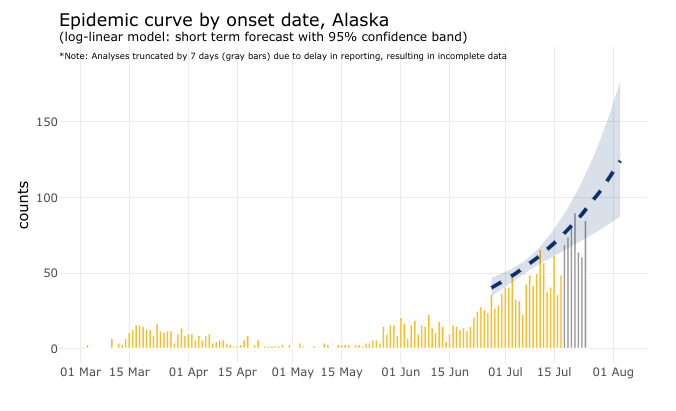
Cumulative Cases by Death, Recovered, and Active Status
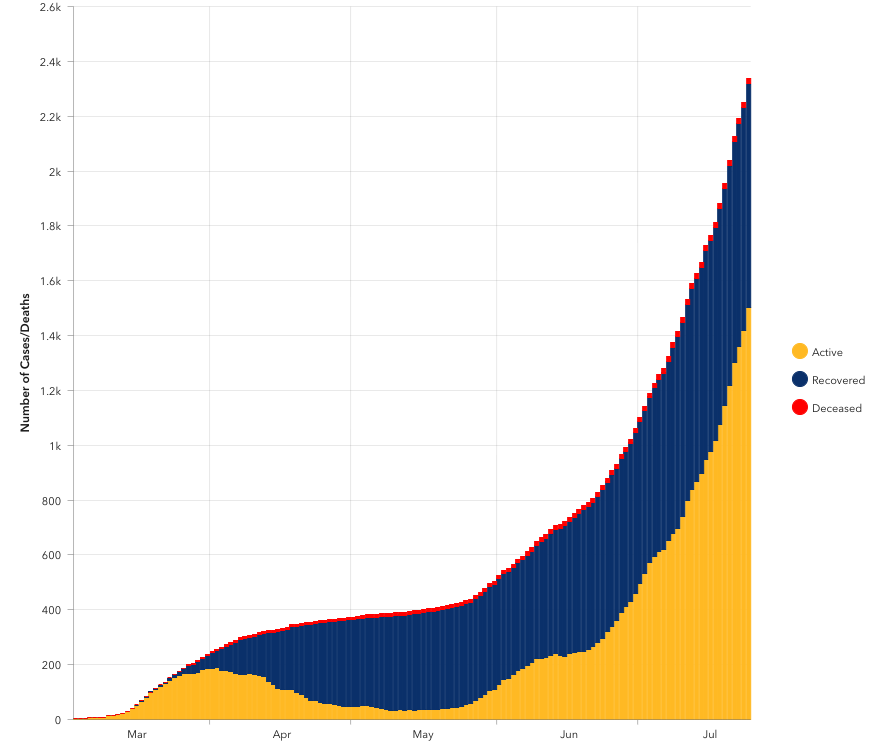
Communities affected this week
New cases were found in Alaskans who are residents of the following communities:
- Anchorage (416), Chugiak (6), Eagle River (7), and Girdwood (1), for a total of 430 new cases in the Anchorage Municipality
- Fairbanks (51), North Pole (8), and Ester (1), for a total of 60 new cases in the Fairbanks North Star Borough
- Wasilla (30), Palmer (11), Houston (1), Sutton-Alpine (1), and Big Lake (1) for a total of 44 new cases in the Matanuska-Susitna Borough
- Kenai (8), Seward (11), Soldotna (6), Homer (4), Sterling (2) and smaller communities (3), for a total of 34 new cases in the Kenai Peninsula Borough
- Cordova (3) and 19 in smaller communities or community in Valdez-Cordova Census Area, for a total of 22
- Yukon-Koyukuk Census Area (13)
- Juneau (13)
- Ketchikan (8)
- Kotzebue (2) and 4 in a smaller community or communities in the Northwest Arctic Borough, for a total of 6
- Sitka (4)
- Yakutat plus Hoonah Census Area (3)
- Southeast Fairbanks Census Area (2)
- Bethel Census Area (2)
- Unalaska (2)
- Utqiagvik (1) and 1 in a smaller community, for 2 total in the North Slope Borough
- Prince of Wales-Hyder Census Area (1)
- Wrangell (1)
- Nome Census Area (1)
- Haines (1)
- Bristol Bay plus Lake and Peninsula Census Area (1)
- Denali Borough (1)
- Aleutians East Borough (1)
Case rates and alert levels
The 7 day case rate map depicts cases adjusted by population for a given region (cases per 100,000 people). The regions are large because Alaska is a large state with few densely populated centers, so this case rate can only be meaningful across large regions. Currently, the Interior region with the exception of Fairbanks North Star Borough has the highest new case rates in Alaska, averaging 29 new cases daily per 100,000 people, nearly double its rate from last week. The Anchorage Municipality has joined it in the red zone with a case rate of 14, up sharply from 9 last week. Next, Fairbanks North Star Borough and Kenai Peninsula Borough had 8.5 and 9.3 respectively, both declined modestly since last week, while Matanuska-Susitna Borough, Juneau City and Borough and the southernmost Southeast region have joined them in orange, with 6.3, 6.7, and 5.7 respectively. The Northwest region is also rising within the yellow category, with a 4.7 rate currently. Most states use a 7 day case rate per 100,000 population to estimate trends in community transmission. Roughly, rates of >10 cases daily per 100,000 population correspond to widespread community transmission and >5 to moderate community transmission, but a sharp increase or decrease in these rates can help predict how the next week or weeks will look for the region.
7-day Case Rate Map (cases per 100,000 people)

Because of Alaska’s unique geography and smaller population, a 14 day case rate can also be useful. The nursing home alert level map below, designed to help long term facilities decide when it may be safer to allow visitors in their facilities, uses a 14 day case rate approach. By that approach, the Interior Region excluding Fairbanks has continued to have rising case rates in the high alert level, with a case rate of 19. Fairbanks itself has come out of the red high alert level to high orange/intermediate, at 9.7. Kenai Peninsula Borough’s rate has risen slightly to 9.6 from 9.3 last week, while Anchorage Municipality has entered the red high alert level with a rate of 10.9. Both Matanuska-Susitna Borough and Juneau City and Borough have entered the intermediate (orange) alert level, with case rates of 5.8 and 5.6 respectively. Other regions had case rates <5.
Alaska COVID-19 Alert Levels
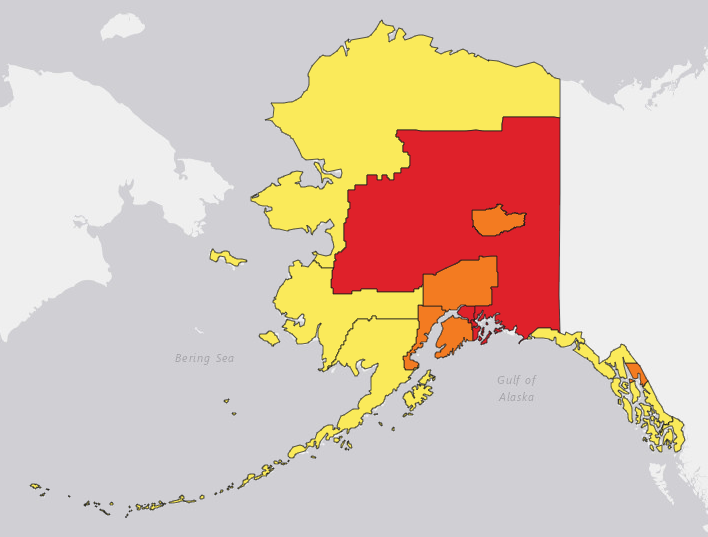
More information on alert levels is available on this page.
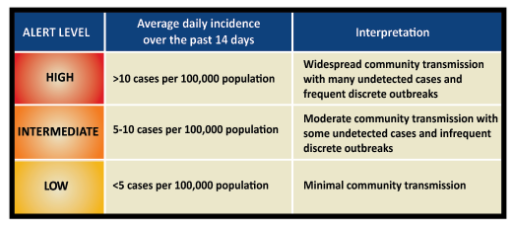
How Alaskans acquired COVID-19
DHSS monitors how people most likely got the virus. In green in the plot below are Alaska residents who acquired COVID-19 by traveling to other states or countries. In March, a substantial proportion of our cases were related to Alaskans returning from elsewhere, while in April and May, fewer Alaskans traveled. Since June, as travel has started to increase, cases in Alaskans related to travel have begun to occur more regularly.
In blue below are cases where Alaskans got COVID-19 from a known contact. These are people who did not leave the state, but we could trace their illness back to the person they got it from. The goal is for contact tracing to identify each of these cases where someone got it from someone else they had contact with so they can let all other contacts of both people know to quarantine. As contact tracing expanded in May, more cases from contacts were identified.
In red, however, are cases where Alaskans got COVID-19 and contact tracing was not able to establish a clear source. This demonstrates that there are other cases in our communities that we have not found yet. The biggest increase in cases in Alaska has been in people aged 20-39, with many cases linked to bars and social gatherings.
Grey bars show the cases where the investigation has not yet concluded. Since the workload for contact tracers has more than doubled in the last few weeks, they are working as fast as possible to identify and quarantine contacts. Alaskans can help contact tracers move faster and prevent more cases by keeping their contact list small, keeping a diary of who they are in close contact with (defined as within 6 feet for 10 minutes or more), wearing cloth face coverings when around any non-household members or in public, and responding promptly to being contacted.
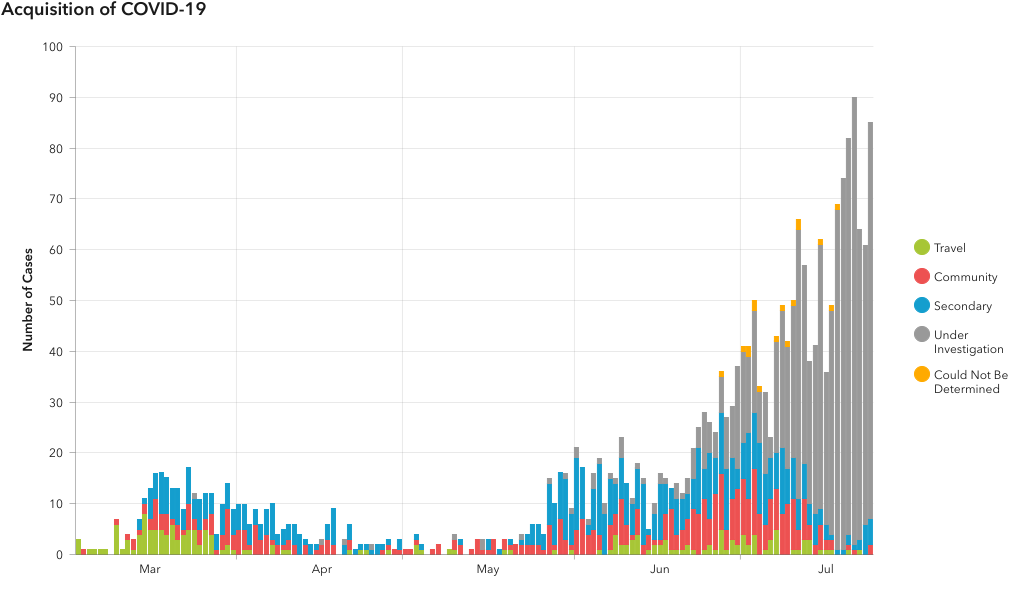
Case distributions
The majority of COVID-19 cases have been found in adults aged 20-39. Gender distribution has been equal, with about half in males and half in females.
A majority of cases have been seen in non-Hispanic white Alaskans, although race and ethnicity information for many cases has not yet been reported. Races and ethnicities of cases, when known, are within a few percent of the proportion of those races and ethnicities in Alaska’s overall population, meaning that at this time a disproportionate burden of COVID-19 in one particular racial or ethnic group is not apparent. However, since this information is unavailable for more than a quarter of recorded cases, it is difficult to draw conclusions from these data.


Of note, of the 2,524 cases in the graph above, 927 cases were under investigation as of July 25, 2020, so the majority of the ‘Unknown’ bar represents cases still under investigation. Of fully investigated cases, 129 people declined to share their race. 56 were of multiple races and 43 were of a race or races not listed here.
Distribution of cases compared to population distribution
Includes data from all cases reporting one or more races. Based on these data, American Indian and Alaska Native as well as Native Hawaiian and Pacific Islander populations are disproportionately affected.
| Race | Percent of cases | Percent of Alaska population |
| American Indian and Alaska Native | 20% | 16% |
| Native Hawaiian and Pacific Islanders | 6% | 1% |
| Black/African American | 4% | 4% |
| Asian | 5% | 7% |
| Multiple | 4% | 8% |
| White | 51% | 65% |

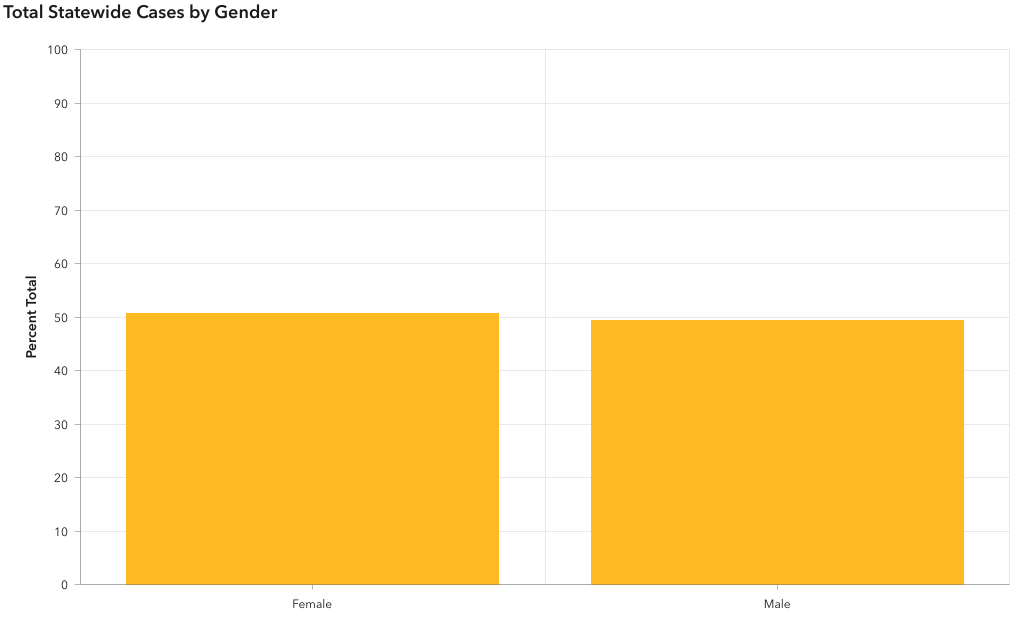
Hospital capacity
Hospitals remain below capacity, with ventilators and ICU beds available, but use is rising. 99 Alaskans have required hospitalization for COVID-19. There has not yet been a sharp increase in need for hospitalization with the rise in cases. However, other states have seen that it can be several weeks before people who get COVID-19 become ill enough to need hospitalization, so DHSS will monitor hospital utilization closely in the coming weeks. Hospitals report all inpatient beds and ICU beds in this total, and not all may be useful for COVID-19. For instance, while Alaska has many NICU beds, these rooms are equipped for infants and may not be helpful for hospitalized COVID-19 patients, the overwhelming majority of whom are adults.


Risk of severe COVID-19 by race and ethnicity
CDC notes that older adults and people with underlying medical conditions are at increased risk for severe illness if they get COVID-19. In particular, CDC specifies cancer, chronic renal disease, COPD, immunocompromised state from a solid organ transplant, obesity (BMI 30 or higher), serious heart conditions such as heart failure, coronary artery disease and problems with the heart muscle, sickle cell disease and type 2 diabetes as carrying an increased risk of severe illness.
Data was immediately available for the prevalence of several of these conditions among Alaskans. Because Alaska’s population is small and the data collected is even smaller, several of these estimates are considered statistically unstable, or not very reliable. However, they are presented here as an example of how different chronic diseases impact different populations of Alaskans, and they may be able to predict increased risk of severe COVID-19 among some populations.
| Race or ethnicity | Cardiovascular disease | COPD | Diabetes | Obesity | Current smoker |
| Multiple races, non-Latino | 3.3%* | 2.4%* | 7.2% | 28.6% | 12.9% |
| Hispanic or Latino | 5.2%* | 5%* | 10% | 23.1% | 25.5% |
| White | 4.2% | 5% | 8.3% | 30.6% | 15.9% |
| Native Hawaiian or Other Pacific Islander | No data available | No data available | 6.6%* | 55.4% | 17.9% |
| Black or African American | 8%* | 6.1%* | 17.2% | 44.3% | 20% |
| Asian | No data available | 2.9%* | 8.6% | 18.7% | 8.5% |
| Alaska Native | 4.6% | 7.4% | 7.8% | 36.3% | 36.8% |
*Statistically unstable: there is not enough data for this category to consider this a reliable estimate
Hospitalizations and deaths by race and ethnicity
Hospitalization percentages are influenced both by the number of people of that race hospitalized and the number of people of that race who have been found to have COVID-19. This means that a population that either has a high degree of severity of COVID-19 and/or a low rate of testing and many undiscovered cases may have a high percent hospitalized shown in state data. Conversely, a population that has many hospitalizations but has a disproportionately high testing rate may have a lower percent hospitalized relative to other groups, since they have fewer undetected cases.
Because Alaska has had 20 deaths related to COVID-19, it is very difficult to draw robust conclusions from these small numbers. Hospitalizations may be a better indicator of actual severity among different populations, since those draw from larger numbers. Other states have had far larger numbers of hospitalizations and deaths and can draw conclusions about trends with more confidence. It is too early to say with confidence whether disparities in severity among Alaskan populations will mirror those in other states. However, state and federal data reflects significant racial disparities in the impact of COVID-19 on minority communities, and Alaskan populations such as Alaskan Natives and Pacific Islanders are known to experience conditions that place them at higher risk for severe COVID-19 at increased rates.
| Race or Ethnicity | Number of cases | Percent of cases who were/are hospitalized | Percent of cases who have died |
| Native Hawaiian and Pacific Islander | 92 | 19.1% | 1.1% |
| Asian | 79 | 13% | 2.5% |
| American Indian and Alaska Native | 318 | 7.5% | 2.2% |
| Hispanic/Latino* | 143 | 4.9% | 0% |
| Black/African American | 70 | 3.2% | 0% |
| Multiple races | 56 | 0% | 0% |
| White | 810 | 5.9% | 1.4% |
| Other | 43 | 11.9% | 0% |
| Unknown | 129 | 8.5% | 0% |
| Not yet identified | 927 | 0.8% | 0% |
| All cases | 2,524 | 4.9% | 1% |
*By federal convention, ethnicity is not mutually exclusive of race.
Reporting of deaths due to COVID-19
20 Alaskans are reported as having died from COVID-19. Although several of these deaths occurred in Alaskans who acquired the disease in another state and never traveled to Alaska during their illness, they are counted as deaths in our reporting by national convention. In accordance with national standards, case counts for Alaska reflect known cases in all Alaska residents, regardless of where they acquired the infection or where it was discovered. This provides consistency and avoids cases and deaths being double-counted between states. Cases found in Alaska that are not among Alaska residents are reported under nonresident cases.
Recovered cases
103 Alaskans recovered from COVID-19 this week, for a total of 815, or 35% of total cases- a decrease of 3% from last week.
Nonresident cases
Of the 171 nonresident cases identified this week, 69 were in the Kenai Peninsula Borough, 41 were in the Aleutians West Census Area, 28 were in Juneau City and Borough, 6 were in the Anchorage Municipality, 3 were in Fairbanks North Star Borough, 3 were in the Fairbanks North Star Borough, 3 were in the Valdez-Cordova Census Area and 1 was in the Ketchikan Gateway Borough. 10 nonresident cases did not yet have their location identified.
136 nonresident cases were associated with the seafood industry, 9 with tourism or visiting purposes, and 4 with other industries.
Testing update
By Saturday evening, 27,533 tests had been resulted this week in Alaska, for a total of 205,066. Test positivity rate for this week averaged to 2.5%, up from 1.72% last week, meaning around 25 in every 1000 tests performed came back positive, increased from about 17 in 1000 last week. Not all positive tests represent distinct positive cases, since occasionally patients with COVID-19 are retested. Retesting did not significantly affect the positivity rate.
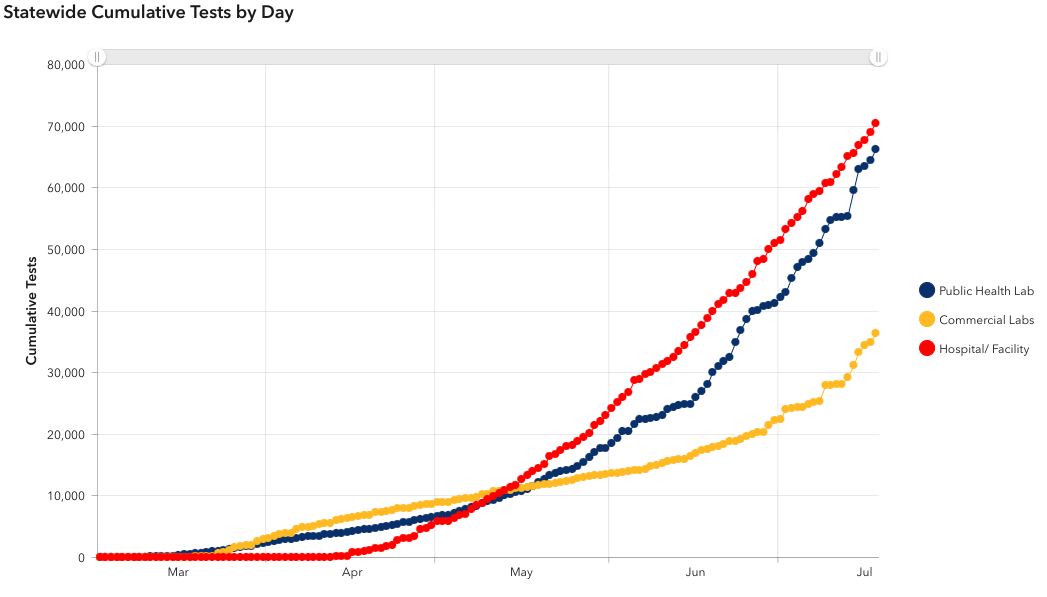
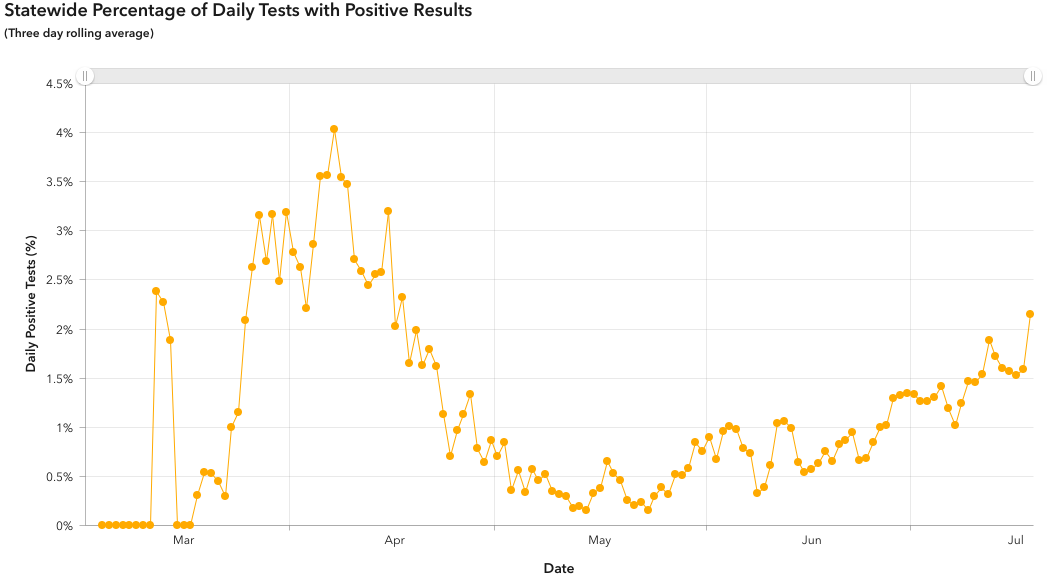
Contact tracing
Ongoing contact tracing has uncovered many cases in Alaskans who have had possible exposures related to group activities. These include churches, residential living facilities, workplaces, bars and social gatherings. Alaskans should be aware that any gathering, particularly indoors, poses some risk of exposure and should take steps to minimize their risk and the risk they pose to others by keeping their social circles small, wearing face coverings, avoiding large gatherings, and gathering only if it is possible to remain 6 feet apart, ideally outdoors. Contact tracing has become even more resource intensive in recent weeks with both an increase in new cases and a marked increase in the number of contacts each person has- meaning that people are expanding their social circles even as case rates increase.
Tourism, visitors and airport testing
Airports report data on a Friday through Thursday cycle, meaning that the airport screening numbers in this section reflect data collected on Friday, July 17th through Thursday, July 23rd.
This week saw 20,557 travelers screened at airports entering Alaska, and 6,019 (29%) opted to be tested on entry. The other options available to them were a 14 day quarantine (selected by 3,016 passengers, 15%) or providing proof of another test performed within 72 hours of landing in Alaska, which 11,293 passengers did (55%). The remaining 229 (1%) provided proof of having recovered from COVID-19, were essential workers following a community and workplace protection plan or were Alaskans who had been gone for fewer than 24 hours. 59 new cases were discovered through airport arrival testing, for a test positivity rate of ~1%.
Since testing began seven weeks ago, 124,174 travelers have been screened at Alaska airports. 51,348 (41%) tested prior to travel, 40,558 (33%) have tested in Alaska airports, and 15,633 (13%) selected a 14 day quarantine. There have been 239 positive tests through airport testing, for an overall test positivity rate of 0.6%.
Of the 171 cases in nonresidents this week, 9 were linked with tourism or visiting, including 2 in the Valdez-Cordova Census Area, one in the Matanuska Sustina Borough, one in the Fairbanks North Star Borough, and four in the Anchorage Municipality. One had not yet had a location identified.
Seafood industry
Of 171 nonresident cases total identified this week, 136 are in workers in the seafood industry, including 65 in the Kenai Peninsula Borough, 41 in Aleutians West Census Area, 28 in the Juneau City and Borough, and 1 in the Valdez-Cordova Census Area. All nonresidents with COVID-19 are quarantined and contact tracing is ongoing for these cases. Most cases are associated with one of three major outbreaks in the seafood industry, including at seafood processing plants in Juneau and Seward and a catcher-processor vessel that docked in Unalaska.
Data timeliness and accuracy
Weekly summaries are published early the following week because that gives the state public health workforce time to collect data, verify accuracy, make sure cases have not been counted in multiple places and verify patient identities. This summary is designed to review a week’s data from the Alaska Coronavirus Response Hub dashboard, which displays same-day or next-day data. The dashboard data occasionally changes as new information is received or as cases are reclassified once verification takes place, since this process takes time. Weekly summaries reflect our most current and complete knowledge about cases in the previous week.
Further information
Please see the State of Alaska COVID-19 information page for more information about the virus and how individuals and businesses can protect themselves and others from transmission.
For the most up-to-date case information, see the Alaska Coronavirus Response Hub dashboard. Some data may change as more information comes to light through contact tracing and other public health work.
For questions regarding DHSS COVID response, including mandates and alerts, email covidquestions@alaska.gov. Since DHSS is experiencing a high volume of inquiries, the Frequently Asked Questions webpage can often be the quickest route to an answer regarding testing, travel, health mandates and other COVID-19 information.
For DHSS media inquiries, please contact clinton.bennett@alaska.gov.
